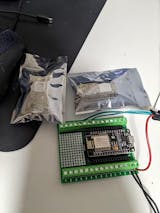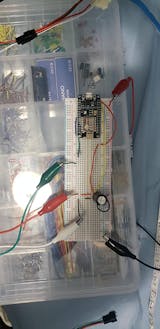NodeMcu ESP8266 V3 Lua CH340 WiFi Development Board


Modern Internet development tools such as Node.js can take advantage the NodeMCU with the built-in API to put your idea on the fast track immediately. NodeMCU is built based on the mature ESP8266 technology to take advantage of the abundant resources available on the web.
NodeMCU has ESP-12 based serial WiFi integrated on board to provide GPIO, PWM, ADC, I2C and 1-WIRE resources at your fingertips, built-in USB-TTL serial with super reliable industrial strength CH340 for superior stability on all supported platforms. This module is one of the cheapest available wifi-modules in the market. V3 or Version3 is the latest version of this module. This tutorial, however, will facilitate you to connect all the versions of ESP8266 NodeMcu, i.e V1, V2 or V3.
1. Arduino-like hardware IO – Advanced API for hardware IO, which can dramatically reduce the redundant work for configuring and manipulating hardware. Code like Arduino, but interactively in Lua script.
2. Nodejs style network API Event-driven API for network applications, which facilitates developers writing code running on a 5mm5mm sized MCU in Nodejs style. Greatly speed up your IOT application developing process.
Development Kit The Development Kit based on ESP8266, integrates GPIO, PWM, IIC, 1-Wire and ADC all on one board. Power your development in the fastest way combination with NodeMCU Firmware!
The NodeMcu is an open-source firmware and development kit that helps you to prototype your IoT product with few Lua script lines. The Development Kit based on ESP8266, integrated GPIO, PWM, IIC, 1- Wire and ADC all in one board.
NodeMcu ESP8266 V3 Lua CH340 WiFi Development Board
Available:In Stock
- Product SKU: KG164
₹ 175
₹ 249
Need Volume Discounts? Deals are specially designed for you. Click here
Need Customization? Provide us more details Click here
🏠
Warehouse Details:


Specification
Description
NodeMcu ESP8266 V3 Lua CH340 WiFi Development Board
The All new NodeMcu ESP8266 V3 Lua CH340 Wifi Dev. Board is a fast leading edge low-cost WiFi technology. Modern high-level mature LUA based technology. It is an integrated unit with all available resources on board. It is super simple to complement your existing Arduino projects or any development board that has I/O pins available.Modern Internet development tools such as Node.js can take advantage the NodeMCU with the built-in API to put your idea on the fast track immediately. NodeMCU is built based on the mature ESP8266 technology to take advantage of the abundant resources available on the web.
NodeMCU has ESP-12 based serial WiFi integrated on board to provide GPIO, PWM, ADC, I2C and 1-WIRE resources at your fingertips, built-in USB-TTL serial with super reliable industrial strength CH340 for superior stability on all supported platforms. This module is one of the cheapest available wifi-modules in the market. V3 or Version3 is the latest version of this module. This tutorial, however, will facilitate you to connect all the versions of ESP8266 NodeMcu, i.e V1, V2 or V3.
1. Arduino-like hardware IO – Advanced API for hardware IO, which can dramatically reduce the redundant work for configuring and manipulating hardware. Code like Arduino, but interactively in Lua script.
2. Nodejs style network API Event-driven API for network applications, which facilitates developers writing code running on a 5mm5mm sized MCU in Nodejs style. Greatly speed up your IOT application developing process.
Development Kit The Development Kit based on ESP8266, integrates GPIO, PWM, IIC, 1-Wire and ADC all on one board. Power your development in the fastest way combination with NodeMCU Firmware!
The NodeMcu is an open-source firmware and development kit that helps you to prototype your IoT product with few Lua script lines. The Development Kit based on ESP8266, integrated GPIO, PWM, IIC, 1- Wire and ADC all in one board.
Technical Details
- Item Type: WiFi Module
- Based On: ESP8266 Based
- Drive Type: Dual high-power H-bridge
- Power Input (V): 4.5 to 9
- Interface voltage (V): 3.3, Communication
- Flash size (MB): 4
- Operating Temperature (°C): -40 to 125
- Transfer Rate (Kbps): 110 to 460800
- ADC / DAC: 1 channel ADC
- Length (mm): 57
- Width (mm): 31
- Height (mm): 11
Features
- Uses CH340G instead of CP2102
- Wireless 802.11 b/g/n standard
- WiFi at 2.4GHz, support WPA/WPA2 security mode
- Support STA/AP/STA + AP three operating modes
- Built-in TCP/IP protocol stack to support multiple TCP Client connections (5 MAX)
- Support UART/GPIO data communication interface
- Remote firmware upgrade (OTA)
- Support Smart Link Smart Networking
- ESP8266 has IO Pin
- Don’t need to download resetting
- A great set of tools to develop ESP8266
- Lowest cost WI-FI
- FOR Arduino-like hardware IO
- Greatly speed up your IOT application developing process
- Open-source, Interactive, Programmable, Low cost, Simple, Smart, WI-FI enabled
- WI-FI MCU ESP8266 integrated and easy to prototyping development kit
- We provide the best platform for IoT application development at the lowest cost
- NodeMCU has built-in USB-TTL serial with super reliable industrial strength CH340G for superior stability on all supported platforms
- Advanced API for hardware IO, which can dramatically reduce the redundant work for configuring and manipulating hardware
- Event-driven API for network applications, which facilitates developers writing code running on a 5mm*5mm sized MCU in Nodejs style
Applications :
- IoT Devices: Used for smart home and automation systems.
- Wireless Sensor Networks: Monitors temperature, humidity, and more.
- Home Automation: Controls lights, fans, and appliances via WiFi.
- Smart Agriculture: Automates irrigation and monitors soil.
- Web Servers: Hosts lightweight apps and remote controls.
- DIY Projects: Ideal for weather stations and smart locks.
- Wireless Data Logging: Uploads sensor data to the cloud.
- Educational Tools: Teaches IoT and programming basics.
- Robotics: Enables WiFi communication for robots.
- Wearable Devices: Powers compact IoT prototypes.
Physical Attributes
- Length (mm): 57
- Width (mm): 31
- Height (mm): 11
- Weight (gm): 10
Package Includes
- 1 x NodeMcu ESP8266 V3 Lua CH340 WiFi Development Board






























